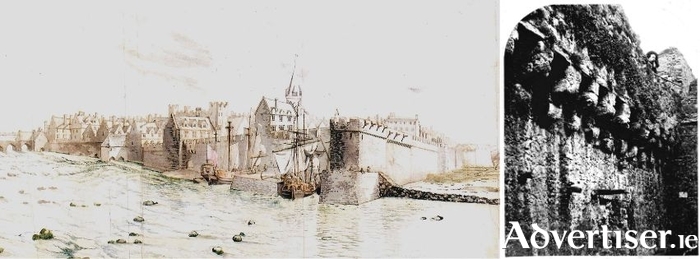The town of Galway was virtually an independent city state, self-contained politically and ecclesiastically, relying on its own resources as it was cut off from the central English authority until the 16th century. Then, the Tudors began to extend their influence westwards so that the city gradually came totally under their dominion. The real symbol of that growing influence was the fortifications, four in number, raised to defend this all-important location against all enemies, notably France and Spain.
The first mention of fortifications occurs in 1548 when Edward VI asked the Mayor and Council of Galway to fortify the port; they were willing but pleaded a lack of funds, the government were willing to advise but not to pay, so nothing happened. The establishment of a garrison of English soldiers here proved unpopular with the natives and gave ‘rebels’ in the west an excuse to attack the city. Some Galwegian merchants whose Spanish trade had been ruined by the English were now trafficking guns and supplies to those rebels. And then, of course, there was the danger from Spain itself, so in 1584, the first fortifications were built at Ceann-a-Bhalla.
Four years later, most of the Spanish fleet perished in the terrible storms off the west coast. It was obvious that this would not be a final defeat for Spain and some years later, they sent another fleet to Ireland. They also ran into bad weather and were forced to land at Kinsale, where they and the army of O’Neill were roundly defeated by Mountjoy. Had they landed in Galway, the result might have been very different, so the English decided to run no more risks, and fortify Galway at once. This was done outside the walls at Forthill. In 1609, the existing fort there was thoroughly overhauled and improved and new fortifications were also built at Mutton Island.
In 1625, the West Gate was fortified.
In 1642, the Irish insurgents set up a government of their own at Kilkenny and appointed Colonel John Burke as Lieutenant-General for Connacht. He was a good strategist and in June 1643, the fort at Galway surrendered to his troops. The Corporation threw open the gates to the Confederate Irish. Galway had won back its independence and the citizens lost no time in strengthening and fortifying the town so as to make the place virtually unassailable. The east and south ramparts were finished quickly. In 1645, the bulwark around Lyon’s Tower was built, and two years later, the flanker about the New Tower, and also the flanker adjoining Lyon’s Tower with the wall and ramparts were completed.
Guns were purchased from France by Order of the Corporation and placed on the fortifications. In 1649, all the gates were repaired, and the new flanker outside the east gate was added. Finally, in 1650, the ramparts and bastions from the east gate to Kirwan’s Tower were finished, thus completing the fortifications around the town, and making it, as far as defences went, the strongest point in the kingdom.
But, it was all in vain. Having conquered the entire country, Cromwell’s army stood before Galway in 1651. On April 5, 1652, the city surrendered. All was lost. The old Corporation, and indeed the old town were wiped out. The city state was at an end.
So, we have two illustrations for you this week, both shown courtesy of the National Library of Ireland. The first is a drawing by Thomas Phillips done in 1685 which shows the West Bridge on the left and Lough Athalia on the right and gives one an idea of the massive defence systems constructed around the city. Our photograph, which dates from c1865 shows one of the very few sections of the fortifications still extant. This wall can be seen opposite the entrance to the city museum.
The drawing is one of the many illustrations in Galway/Gaillimh number 28 in the Irish Historic Towns Atlas series which is compiled by Jacinta Prunty and Paul Walsh. This remarkable publication is a must for every Galway Library, a wonderful collection of maps and illustrations of the city from the earliest days to the present, accompanied by a very informative texts. Very highly recommended. In good bookshops.

